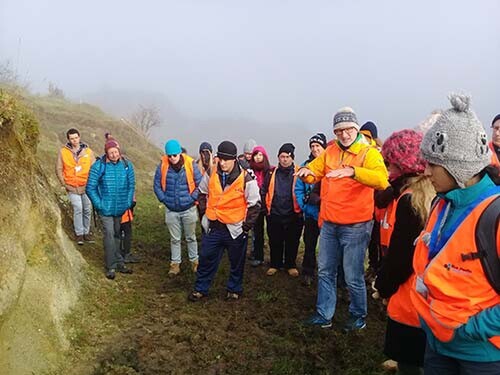Best work day ever! On Friday, Blue Pacific Minerals hosted a group of 50 scientists attending the 2018 Astrobiology Australasia Conference being held in Rotorua on a morning field trip to the BPM Z-3 zeolite quarry in Ngakuru. Nigel Kewish, BPM's zeolite global sales manager, started the day with a brief overview of the commercial applications for the zeolite deposit before the discussion turned to the fascinating geology of the site. The professional group, studying hydrothermal environments, have been viewing hot springs in Australia and New Zealand as a stepping stone to looking into deep time and the origins of life on earth.
The Blue Pacific Minerals zeolite quarry lies in the heart of the Taupo Volcanic Zone where Zeolites were formed through volcanic activity forcing warm water up through the sediment deposit causing zeolitisation. The type of clay that is deposited, the temperature, acidity and quantity of thermal water that penetrated the deposit determined the type of zeolite that was formed.
Professor Martin Van Kranendonk, Director of the Australian Centre for Astrobiology at the University of New South Wales explained, (very kindly in simple English) that he studies the ancient geologic sites of North Western Australia, the oldest hydrothermal location on earth at 3 ½ billion years old. The group are in NZ studying recent hydrothermal sites such as our own zeolite deposit which is one of the world's youngest (between 100,000 and 200,000 years old). The scientists are here to see the differences between the earliest ancient deposits and latest ones. They believe that the ancient environments now fossilised in Western Australia were very similar to what we see around hot springs in Rotorua today, and we need to look no further than in our backyard, to bring further understanding to the extreme conditions under which early life flourished. Current thinking is that the earliest life on earth happened not in the oceans as previously thought, but in geothermal waters like ours.
The Centre for Astrobiology is also officially affiliated with NASA, working on a Rover mission to Mars planned for launch in 2020. The North Western Australian rock geology offers a deep time analogue-equivalent site to the surface crust of Mars. The scientists are using this deep time area to inform the Martian explorer community about what to look for in their search for life on the Red Planet.
Mitch Schulte a programme scientist in the Mars Exploration Agenda at NASA headquarters in Washington told me that they have the capability now, to look in fine detail at the surface crust of Mars. They will be exploring the geology of the landing site (which they are currently choosing from a range of landing site possibilities) searching for records in the rocks, using this information to find out if life may have once existed there. From a launch date yet to be determined, the Rover will take 7 ½ months to get to Mars and has a precise landing time calculated for 3.30pm on February 19th 2021.
Apparently, Mars is clearly visible in the night sky at the moment, a few hours after moon-rise to the right and down a bit. With clear skies forecast for this week, it's a good time to be looking up in wonder.
